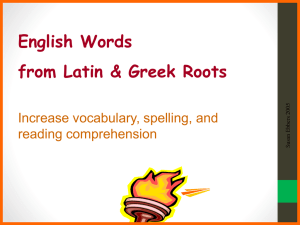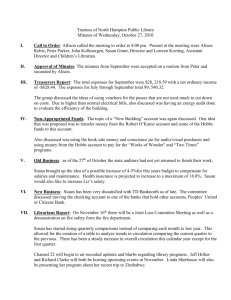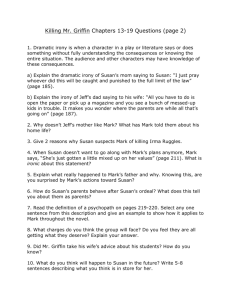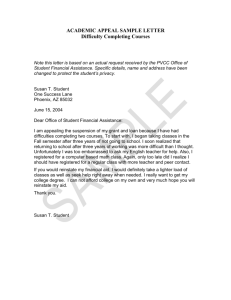Vocabulary-Morphemes--PP
advertisement
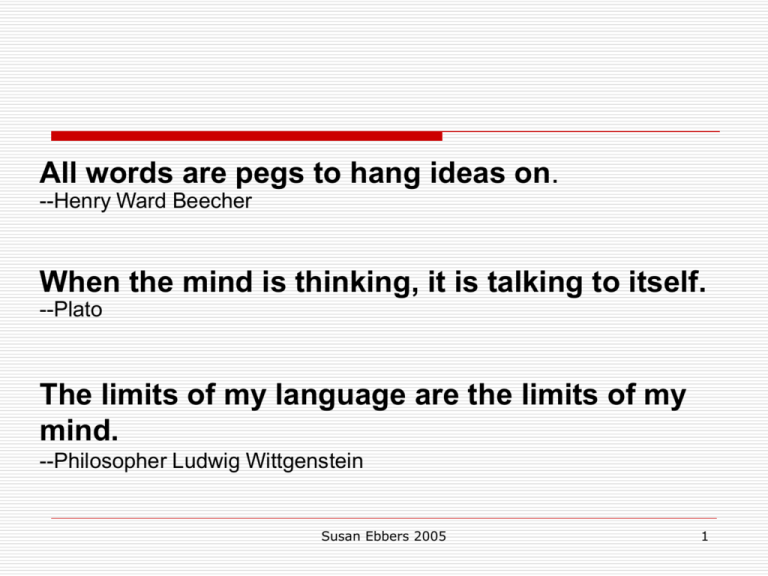
All words are pegs to hang ideas on. --Henry Ward Beecher When the mind is thinking, it is talking to itself. --Plato The limits of my language are the limits of my mind. --Philosopher Ludwig Wittgenstein Susan Ebbers 2005 1 "The greatest benefit from instructional time spent on word study can be gained from exploring roots, prefixes, suffixes, and networks of related words" --Henry,1997 Susan Ebbers 2005 2 MORPH OLOGY Gr. form, structure Gr. study of Morphology is the study of the structure of words as it relates to meaning. It is structural analysis. Morphology may also include the study of word history: etymology. Susan Ebbers 2005 3 Basic Terms morpheme: smallest unit of meaning in a word Ex: biographers: 4 morphemes: bio-graph-er-s Types of Morphemes: root or combining form: inspector, thermal base word: unlikely prefix: re-, un-, dissuffix: -able, -ive, -ly } affixes derivation-a word formed from an existing word, root, or affix: electric, electricity Susan Ebbers 2005 4 Are these real words? What might they mean? •ugsome •malductive •triskaidekaphobia •hydronauts Susan Ebbers 2005 5 Research Confirms Structural Analysis •Content Area Reading •English Language Learners •Spelling Skills •Vocabulary Acquisition •Fluency and Rapid Word Recognition •Comprehension Susan Ebbers 2005 6 Singson, Mahony, and Mann studied upper elementary students and found that their understanding of morphemes contributes to both decoding and spelling ability (2000). Abbott and Berninger concluded from their studies that older struggling readers benefit from learning the composition of English words, which includes their basic structure of prefix, root, suffix, syllable formation, and morpheme patterns (1999). Susan Ebbers 2005 7 Sally Shaywitz, M.D. has determined that "Knowing the etymology or the roots of a word is a very powerful aid to reading, shedding light on a word's pronunciation, its spelling, and its meaning Shaywitz, 2003, p. 207 Arnbak and Elbro determined that morphological awareness training (learning prefixes, roots, and suffixes) significantly increased both comprehension and spelling of complex words in dyslexic readers in fourth and fifth grade. In a second study with older secondary students, they found that "dyslexic adolescents use recognition of root morphemes as a compensatory strategy in reading both single words and coherent texts.” 1996, 2000 Susan Ebbers 2005 8 Another entry point for adding words to the environment is morphological relationships. For example, challenge students to compare Tyrannosaurus and tyrant; pedestrian and pedal; duplicate and duplicity…. Beck, McKeown, & Kucan, 2002, p. 128 Susan Ebbers 2005 9 The mind analyzes every stretch of language as some mixture of memorized chunks and rule-governed assemblies --Steven Pinker, 1999 Susan Ebbers 2005 10 ALL MIXED UP You know this language that we speak, is part German, part Latin, and part Greek --Peter, Paul, and Mary Susan Ebbers 2005 11 French Anglo-Saxon Greek Latin Susan Ebbers 2005 12 Susan Ebbers 2005 13 Anglo-Saxon: Germanic Indo-European Origins common words: love, child, house, heart (often one syllable) vowel teams: teeth, foot r-controlled: farm, star, storm, shirt wh-what, sh-ship, th-thumb, ch-church, ng-king, nk-thank prepositions, articles, conjunctions: with, to, for, and, the, but… compound words: mankind, blackbird words with silent letters: knee, night, comb, wrinkle, could, thought Susan Ebbers 2005 14 "Silent letter patterns such as kn-, wr-, -ough, -ould, and -igh are remnants of Anglo-Saxon, in which those "silent" letters were sounded." McCardle & Chhabra, 2004 Susan Ebbers 2005 15 **The brain needs to be prepared for the transition from Anglo-Saxon to Latinate words for three reasons. 1. Students speak Anglo-Saxon but begin to read and write Latin-based derivatives 2. Spelling patterns change: /sh/ -- ci, ti, si; /f/ -- ph, etc. 3. Structural changes: Latin prefix-root-suffix,Greek combining forms, multisyllabic words with schwa Without this preparation for a change in word structure the brain may be perplexed. Berninger & Richards, 2002, p. 233-234 Susan Ebbers 2005 16 Susan Ebbers 2005 17 LATIN STRUCTURE • Latin words follow a strict structure • Prefixes, if used, must be placed before the root and suffixes must follow the root • Latin roots (spect, vis, ject, rupt) are unlikely to stand alone as an English word • The Latin root usually receives the accent or stress: •e ject' •port' ability •in script' ion •at tract' ive Susan Ebbers 2005 18 Latin: Some Common Roots trans dis pre re inter pro de con dis sub port rupt script tract cept ject struct duct miss vers e dict able ion ion or ion ile ion or al ive Susan Ebbers 2005 to carry to break to write to pull to take to throw to build to lead to send to turn to speak 19 White, Sowell, and Yanagihara (1989) found that third-graders who were given training on the nine most common prefixes and a strategy for decomposing words into roots and suffixes outperformed a control group on several measures of word meaning. They concluded that teaching at least the top nine (if not all twenty) to middle school students would pay dividends in increased vocabulary learning. Susan Ebbers 2005 20 20 Most Frequent Prefixes in School Texts 1. unable 2. review inedible (impotent, illegal, irresponsible) distrust enlighten (empower) nonsense inside, implant overcome misguided submarine prefix interrupt forewarn derail transfer supersonic semicircle antitrust midterm underfed Susan Ebbers 2005 Analysis: White, Sowell, and Yanagihara 1989 21 Prefixes: Meaning and Connotation Often Negative Somewhat Positive dis-, de- non- sub- pro- co- bene- in- un- mis- super- com- be- mal- anti, contra a- en-, em- ad- Susan Ebbers 2005 22 report reporter support supporter supportive unsupportive supportively deport deportee deportation import importer importation portfolio portable transport transporter transportation portability port: to carry (L.) Susan Ebbers 2005 23 Word Webs or Spoke Diagrams Create networks of related words. Make a word web, spoke diagram, or root tree for the Latin stem script or scrib, meaning to write describe scribble prescription scripture Susan Ebbers 2005 24 Joanne Carlisle's studies suggest that proficient readers and spellers use knowledge of affixes and roots as they read and spell, while poor readers and spellers "lack awareness of the presence of base forms within derived counterparts, and they lack specific knowledge about how to spell suffixes and how to attach suffixes to base words correctly” 1987, pp. 106-107 Susan Ebbers 2005 25 Susan Ebbers 2005 26 GREEK WORD ORIGINS •a y for /i/ as in symphony and typhoid •a ch for /k/ as in chorus and chaos •a ps for /s/ and in pseudonym and psychology •a ph for /f/ as in sphere and epitaph •the letter x as in xylophone, dyslexia, xenophobe Greek morphemes have no strict structure: •graph •biography •graphic •mimeograph Susan Ebbers 2005 27 Greek Combining Forms hydro graph geo pyro polis neuro ortho scope photo therm crat psych chron phobe pseud onym crypt helio logy sphere the, theo Susan Ebbers 2005 28 Counting in Greek and Latin mono uni di bi du, duo tri tetra quadri penta hexa sept oct nove deca deci cent milli poly multi semi hemi Susan Ebbers 2005 29 Developing content-specific, academic vocabulary depends on a basic understanding of Greek and Latin Sixty percent of the words in English texts are of Latin and Greek origin Bear et al., 1996; Henry, 1997 Susan Ebbers 2005 30 grammar school grammar books rules of grammar grammatical grammatically ungrammatical ungrammatically grammatology grammar photograph polygraph mimeograph phonograph telegraph paragraph gram, graph to write, written Greek graph telegram mammogram histogram gram anagram cryptogram monogram electrocardiogram graphite grapheme graphologist graphic graphically Susan Ebbers 2005 photographer cartographer geographer cryptographer autobiographer xylographer paleographer biographer 31 Look Inside—Look Outside pneumonoultramicroscopicsilicovolcanoconiosis 1. Look inside the word for known word parts: prefixes, roots or combining forms, suffixes. 2. Use the analogy strategy—“I don’t know this word, but I know pneumonia and I know volcano, so by analogy, this word might have something to do with lungs and heat.” 3. Look outside the word at context clues, visuals The coal miners, coughing and wheezing, suffered from pneumonoultramicroscopicsilicovolcanoconiosis. Susan Ebbers 2005 32 SO MANY ENGLISH WORDS Oxford English Dictionary ~615,000 words Webster's Third New International English Dictionary ~450,000 words ~200,000 words in common use Millions with technical and scientific terms (Bryson, 1990; King, 2000) Susan Ebbers 2005 33 SO MANY SYNONYMS ANGLO-SAXON, FRENCH, LATIN, and GREEK Anglo-Saxon French Latin or Greek cook sauté concoct holy sacred consecrated kingly royal regal wreck sabotage subvert hearten encourage inspire show cinema theater See also Bryson, 1990; Lederer, 1991; King, 2000 Susan Ebbers 2005 34 ENGLISH: A RICH VOCABULARY SO MANY SHADES OF MEANING “A Positive Emotion” GLAD PLEASED DELIGHTED OVERJOYED HAPPY CAREFREE LIGHTHEARTED MERRY JOYOUS JOYFUL CHEERY CHEERFUL CONTENT BLITHE BLISSFUL SATISFIED BOUYANT BEATIFIC ECSTATIC EUPHORIC EUPEPSIC Susan Ebbers 2005 35 Man does not live by words alone, despite the fact that sometimes he has to eat them! --Adlai Stevenson Susan Ebbers 2005 36 THANK YOU Merci Danke Gratias ευχαριστώ /efharisto/ Susan Ebbers 2005 37

